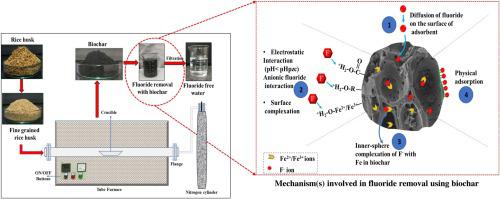Journal of Analytical and Applied Pyrolysis ( IF 5.8 ) Pub Date : 2021-01-07 , DOI: 10.1016/j.jaap.2021.105015 Krishna Yadav , Sheeja Jagadevan

|
Natural and anthropogenic activities leads to massive contamination of groundwater with various organic and inorganic pollutants. Of these, fluoride is a major contaminant and elevated concentration of fluoride results in many health-related issues such as dental and skeletal fluorosis. This study aims to exploit an agricultural waste (rice husk) as a feedstock for synthesis of a value-added product (biochar), for effective defluoridation of drinking water. To that effect, thermal (torrefaction/pyrolysis) and chemical (iron/zinc) activation of rice husk-derived biochar were tested. Activation of biochar via pyrolysis followed by iron modification was capable of maximum fluoride removal (95.4 %). Optimized conditions for fluoride adsorption were time (120 min), biochar dose (4 g/L), solution pH (4) and initial F− concentration (5 mg/L). Additionally, a predictive modelling was carried out using an artificial neural network (ANN) model with four input variables and one output variable. Accuracy of the model was tested using error functions such as mean absolute error (0.002), root mean squared error (0.32) and coefficient of determination (0.99) for training, 3.78, 13.54 and 0.62 for validation and 5.10, 6.66 and 0.98 for testing respectively. Langmuir isotherm was best suited model among the isotherms tested with adsorption capacity of 4.45 mg/g. Rice husk derived biochar was found to be an economically viable alternative to commercially available adsorbents, which could also be employed for the remediation of other groundwater pollutants.
中文翻译:

焙干和热解对工程生物炭的影响及其在脱氟中的应用:洞察吸附机理,间歇式吸附器设计和人工神经网络建模
自然和人为活动导致地下水被各种有机和无机污染物大量污染。其中,氟化物是主要污染物,氟化物浓度升高会导致许多与健康相关的问题,例如牙齿和骨骼氟中毒。这项研究旨在开发一种农业废料(稻壳)作为合成增值产品(生物炭)的原料,以有效地对饮用水进行除氟。为此,测试了稻壳衍生生物炭的热(焙烧/热解)和化学(铁/锌)活化。通过热解激活生物炭,然后进行铁改性能够最大程度地去除氟化物(95.4%)。对于氟化物吸附优化条件为时间(120分钟),生物炭剂量(4克/升),溶液的pH值(4)和初始F -浓度(5 mg / L)。另外,使用具有四个输入变量和一个输出变量的人工神经网络(ANN)模型进行了预测建模。使用误差函数测试模型的准确性,例如平均绝对误差(0.002),均方根误差(0.32)和确定系数(0.99)(用于训练),3.78、13.54和0.62(用于验证)以及5.10、6.66和0.98(用于测试)分别。Langmuir等温线是最合适的模型,其吸附容量为4.45 mg / g。发现稻壳衍生的生物炭是商业上可买到的吸附剂的经济可行替代品,后者也可用于补救其他地下水污染物。










































 京公网安备 11010802027423号
京公网安备 11010802027423号